RESTORATION AND MANAGEMENT OF ESOX LUCIUS BREEDING GROUNDS IN FLOODPLAIN THE NATURA 2000 MANAGEMENT PLAN (DOCOB) The site's Docob was elaborated in three phases, and accepted on the 04-06-1998, 10-10-2001 and 12-12-2005. As part of the 1998 action plan (section « water and hydrology), an action is named « Maintain or restore fishbreeding sites (river or floodplains) OBJECTIVES For the floodplain, this action aims at preserving the hydrological functions of the long-lasting submersions of lowlying meadows of the valley. More specifically, it aims at preserving or restoring fish natural habitats of the floodplain, particularly those of Esox lucius considered to be a good indicator of the lowlying meadows and aquatic and riparian habitats conservation state. CONTENTS Develop tools and techniques permetting to maintain, restore and manage fish breeding sites of the floodplain ; the first local problem being mostly to re-establish the connection between the breeding site and the river:-
The action also benefits from other existing tools:-
PARTNERS FDPPMA 17 : leader of the project. Coordinates all, acquires land, realises fish diagnostics and post-actions fish surveys, leads and surveys the works conducted on sites, gives environmental advice for local stakeholders and project partners… Local stakeholders : manage the hydraulic systems (periods ands waterlevels are determined in a management agreement between them and the FDPPMA) Docob coordinating structure : makes the links and the coherence between the action untertaken, and the aims of the Docob.
RESULTS INDICATORS: fish breeding success survey.
EXAMPLES OF REALISATIONS
EXAMPLE 1: CHANIERS: Private land near Charente river (1ha 74a), out of which are lowlying meadows (the fish breeding site does not function properly because the ditch is full of mud : therefore, the young fish cannot return to the river once grown).
EXAMPLE 2: PRAIRIE DE ST SORLIN: Context: The lowlying hay meadow « Prairie de Saint-Sorlin » (87ha, Saintes) is a vast (87ha) sector of preserved floodplain along the river Charente and its derivation chanel. |
|
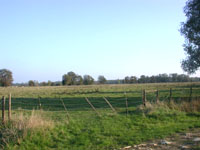
| |
| Prairie de Saint-Sorlin à Saintes | |
| Within this sector, 3 hunting stations are found, one of which is not in use anymore. Thses hunting stations are in fact low-lying sectors of the meadow which receive water from the river during winter and spring floods, through direct fllod and/or ditches and hydraulic systems. When flooded, they become excellent habitats for ducks. Moreover, the flooding period of hunting stations is also the good Esox lucius reproduction period. That is why it is interesting to have management agreements between hunters and FDPPMA organisation : a participation to the functionning maintenance (ditches maintenance, hydraulic system restoration) can be organised. Moreover, the whole meadow system in this sector constitutes a vast potential Esox lucius breeding ground. To enhance this potential, improvement should be made to hydraulic connexions between hunting stations, ditches, River, derivation cala and meadows. Works conducted: In 2004, the owner of the 2 hunting stations was approached by FDPPMA, which resulted in:
Management agreement:
The aim is to allow the incoming of reproductive adults on the inundated meadow, and then maintain the high water level.
| |
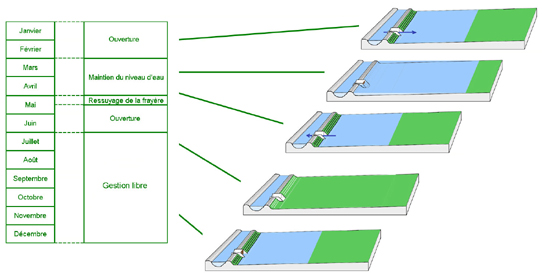
| |
| Calendrier prévisionnel de gestion de l'ouvrage | |
| Results survey: Survey of breeding Esox lucius will be conducted in 2005. EXAMPLE 3: MONTILS: Context: This restoration project initiated from the local Organisation for Fishing and Protecting of Aquatic habitats « Les Pêcheurs de la Seugne », in agreement and total partnership with the owner. Th Montils site is particularly good as Esiox lucius breeding grounds, and was a long term known site (old people memory for instance). The site directly borders the river Seugne. The owner, very positive and happy about the project, plans to organise a horse's and pedestrian pathway along the site and might propose an interpretation plan to allow the public to learn about Esox lucius and wet meadows in general. Works conducted The ringing ditch, completely fulled up with mu and vegetation, was restored to functionality in 2003, based on topographical surveys. A complementary clearing out was conducted in 2004 to enhance hydraulic connections with other existing ditches on the site ands the river, and therefore improve agin potentialities. |
|
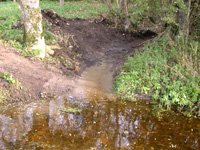
| |
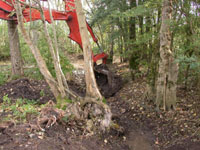
|
|
| Improving hydraulic connexions | |
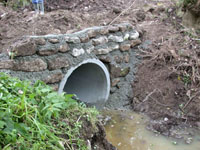
| |
| Connecting ditches under the road (800mm) | |
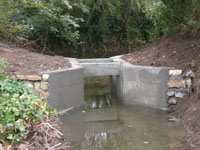
|
|
| Water levels management sluice | |
| The sluice management has been given to the owner through a management agreement. Management agreement: |
|
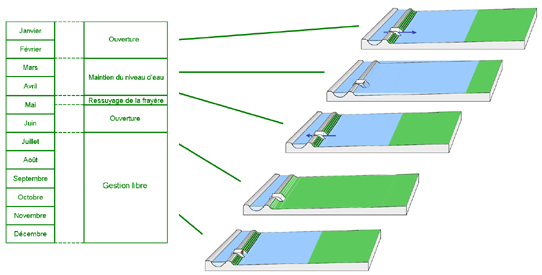
|
|
| Calendrier prévisionnel de gestion de l'ouvrage | |
|
First results: A female was found (dead and full of eggs ; reason unknown although analyses were conducted) in march 2004 near the ditch cleared out in 2003. No young fish were found in the following spring and surveys will be conducted again in 2005.
|